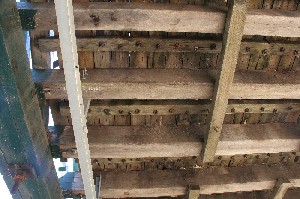Home | Old
PWD Truss Bridges | McDonald Truss Bridges | Allan
Truss Bridges | de Burgh Truss
Bridges | Dare Truss Bridges | Other Bridges
The second type of timber truss bridges are the McDonald
truss bridges. John McDonald was the Engineer for Bridges for the
Public Works Department of NSW. He made some major improvements to the
Old PWD truss which reduced maintenance costs and increased the strength
of the truss. McDonald truss bridges were built from 1880-1902. They
looked similar to the Old PWD truss. The main differences were the
elimination of the double thickness top chord, the addition of splayed
end chords and the use of iron cradles for the tension rods at the ends
of the top chord. The splayed ends provided better support and better
distribution of the forces transmitted to and from the top chord. The
iron cradles for the tension rods removed the need to drill holes in the
ends of the top chord.
In spite of these improvements, the truss still retained the single
thick timber beam for the top chord.
McDonald truss bridges have a
flattened appearance compared to the more common Allan and Dare trusses.
Statistics
Number built: 91
Number remaining: 5
Number to be preserved: 3
| Bridge Name |
Date Built |
# of Spans |
Location |
Waterway Name |
Status |
To be preserved? |
| Crankies Plains |
1902 |
2 |
Bombala |
Coolumbooka River |
Not rebuilt |
Yes |
| Galston |
1902 |
1 |
Galston Gorge |
Tunks Creek |
Original |
Yes |
| Junction |
1895 |
3 |
Tumut |
Tumut River |
Rebuilt |
Yes |
| Five Day Creek |
1902 |
1 |
Armidale-Kempsey Rd |
Five Day Creek |
Demolished |
No |
| McKanes Falls |
1893 |
2 |
Lithgow |
Coxs River |
Not rebuilt |
Yes |
Back to top
This bridge is located on the Bombala-Cathcart Road about 2km from
Bombala. It is a two span bridge built in 1902and crosses the Coolumbooka
River. In my opinion, it is the best looking of the McDonald trusses and
is located in a beautiful setting. Part of the reason of its good looks
is that it has very little weather shielding installed, and none on the
sloping end chords. This bridge will be preserved. This bridge has not
been upgraded with modern materials.
Back to top
This bridge is a two span bridge located on McKanes Falls Road about 5km
south of Lithgow. It was built in 1893 and crosses the Coxs River. It is
one of the few timber truss bridges in NSW that are not painted white.
The centre pier was originally constructed of masonry similar with the
abutments but was shifted downstream by flood in the early 1980s. It was
replaced with a concrete pier. The bridge is going to be preserved and
will eventually be restored and upgraded. Update May 2022: This bridge is
currently undergoing a full rebuild.

View of the underside. This view shows the bottom
chord, composed of four separate beams (flitches) bolted together.
Back to top
Galston Bridge is a single span bridge located on Galston Road. It was
built in 1893 and crosses Tunks Creek in Galston Gorge, east of Hornsby.
It is the shortest of all the remaining timber truss bridges in NSW.
This bridge is going to be preserved without upgrading with modern
materials as it does not have to carry heavy loads due to the road
having a load limit.
Back to top
Junction Bridge is a three span bridge located on Tumut Plains Road, about
4km east of Tumut. It crosses the Tumut River and was built in 1895. The
bridge has been completely restored and strengthened. According to the
RMS (Roads and Maritime Services) here, this
involved replacing one of the bottom chord flitches with a steel flitch,
replacing the crossbeams with steel, replacing the approach spans with
concrete, replacing the railing and adding more stay braces (the pieces of
steel angle holding the trusses upright on the outside of the bridge). The
result is very good. The only thing I don't like is the new railing.
While made to resemble the original railing, it is still very obviously
not original. The bridge was also painted white, instead of the two tone
green and brown it used to be.
Back to top
Driving view of the four McDonald truss bridges still open to traffic.